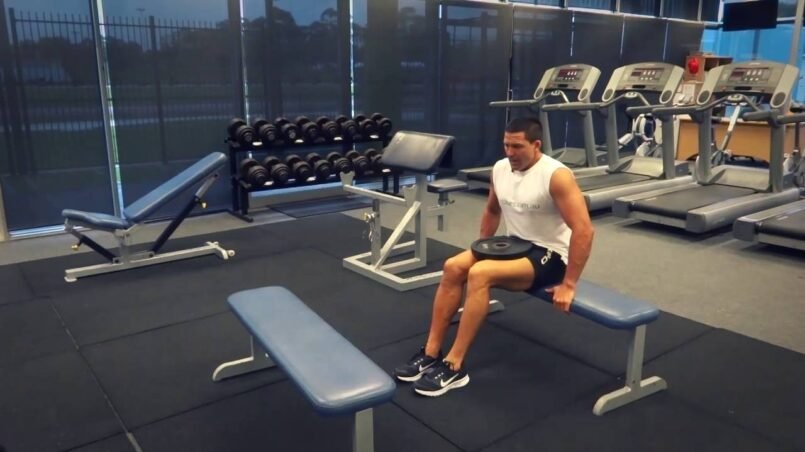
Weighted bench plunges are a phenomenal bodyweight practice that basically focuses on the rear arm muscles, shoulders, and chest muscles. By adding loads, you can escalate the exercise, developing fortitude and bulk in the chest area. This article will cover everything from the advantages of weighted bench plunges, appropriate procedure, muscle bunches included, varieties, normal mix-ups, and ways to integrate this activity into your wellness schedule.
1. What are Weighted Bench Plunges?
A bench plunge is a bodyweight practice where the lifter utilizes a bench or one more raised surface to play out a plunge. The development centers around the rear arm muscles while additionally captivating the chest and shoulders. At the point when loads are added, either through a weighted vest, plates on the lap, or another strategy, the trouble increments, making it more trying for muscle development and strength.
2. Muscles Designated by Weighted Bench Plunges
The weighted bench plunge is principally a compound activity, meaning it draws in numerous muscle gatherings:
- Rear arm muscles: The essential muscle worked during bench plunges, the rear arm muscles are answerable for broadening the elbow.
- Pectorals: The chest muscles assume a steady part in the development.
- Deltoids (Shoulders): The forward portion of the deltoids is enacted during the plunge, giving soundness and backing.
- Center Muscles: To keep the body consistent, particularly when weight is added, the center is locked in.
- Lower Back: Like the center, the lower back settles your body all through the development.
3. Advantages of Weighted Bench Plunges
- Further developed Rear arm muscles Strength: Since the rear arm muscles are the principal muscle designated, bench plunges can assist with serious areas of strength for building, arms.
- Improved Chest area Strength: The activity connects with the shoulders and chest, making it powerful for generally speaking chest area strength.
- Expanded Bulk: Adding loads builds the obstruction, which can assist with advancing muscle development.
- Further developed Perseverance: Over the long run, predictable practice works on solid perseverance.
- Comfort: You can do weighted bench plunges anyplace, as long as you have a bench and some additional weight.
4. Step by step instructions to Perform Weighted Bench Plunges
Playing out a weighted bench plunge accurately is urgent for keeping away from injury and expanding the advantages. Here is a bit by bit guide:
1. Set Up:
- Sit on a bench or strong surface.
- Put your hands on the edge of the bench, right external your hips, with your fingers looking ahead.
- Expand your legs before you. For amateurs, keeping the knees bowed and feet level on the ground is suggested, yet for further developed people, you can keep the legs straight.
2. Adding Weight:
- In the event that you’re adding weight, put a plate on your lap or wear a weighted vest. Guarantee the weight is secure to try not to move during the development.
3. Bringing down Stage:
- Slide your hips off the bench and lower your body by bowing your elbows.
- Keep your elbows pointed in reverse, not erupting out to the sides.
- Lower yourself until your upper arms are lined up with the ground or you feel a profound stretch in your rear arm muscles.
4. Pushing Stage:
- Press through your palms, pushing your body back up to the beginning position.
- Ensure you completely broaden your arms at the highest point of the development.
5. Redundancies:
- Rehash the development for your ideal number of redundancies. Hold back nothing sets of 8-12 reps for muscle development or 12-15 reps for perseverance.
5. Normal Varieties of Weighted Bench Plunges
Switching around your bench plunges can forestall levels and target different muscle gatherings. Here are a few varieties to attempt:
1. Single-Leg Weighted Bench Plunge:
Broaden one leg off the floor while playing out the plunge to expand the trouble and work on security.
2. Bench Plunge with Raised Legs:
Lift your feet by putting them on another bench or a solid surface. This expands the scope of movement and makes the activity harder.
3. Decline Weighted Bench Plunge:
For an additional test, place your feet higher than your hands by utilizing a lower bench or raised surface. This puts more accentuation on the shoulders and rear arm muscles.
4. Helped Weighted Bench Plunge:
On the off chance that you’re a novice, use obstruction groups under your body to help you in lifting. This aides in developing fortitude continuously.
6. Weighted Bench Plunge Varieties with Hand weights
On the off chance that you’re hoping to move forward the power much more, involving hand weights for extra opposition is an incredible choice:
- Hand weight Weighted Plunges: Spot a free weight between your legs, simply over your knees, to increment opposition.
- Iron weight Weighted Plunges: Like hand weights, you can hold a portable weight in your lap for added opposition.
- Plate Plunge: On the off chance that you don’t have hand weights, utilize a weight plate and put it on your lap while performing plunges.
7. Normal Missteps to Stay away from
Performing bench plunges inappropriately can prompt injury. Here are a few normal slip-ups and tips to stay away from them:
- Elbows Erupting Out: Keep your elbows wrapped up as opposed to erupting them out. This lessens weight on the shoulders.
- Not Diving sufficiently deep: To capitalize on this activity, your arms ought to arrive at basically a 90-degree point at the lower part of the development.
- Inclining Excessively Far Forward: This moves the concentrate away from the rear arm muscles and onto the shoulders. Keep your body upstanding to actually focus on the rear arm muscles.
- Depending on Force: Control the development, particularly while adding weight. Try not to bob all over during the plunge.
- Over-burdening on Weight Too early: Assuming you’re new to weighted plunges, fire light and move gradually up. It’s smarter to play out the activity accurately with less weight than to rapidly gamble with injury by over-burdening as well.
8. Ways to amplify Results
- Warm-up Appropriately: Prior to hopping into weighted bench plunges, guarantee you have a legitimate get ready to jump-start the system and the joints prepared. Integrate dynamic stretches or lighter rear arm muscle practices like push-ups or rear arm muscle payoffs.
- Moderate Over-burden: Continuously increment the load as your solidarity gets to the next level. Begin with bodyweight plunges, then add loads continuously.
- Consolidate with Different Activities: For generally speaking chest area strength, join bench plunges with practices like push-ups, pull-ups, and shoulder presses.
- Recuperation: Remember to give your muscles time to recuperate. Go for the gold 48 hours between rear arm muscle exercises to permit the muscles to fix and develop.
- Consistency: Consistency is key with regards to getting results. Incorporate weighted bench plunges in your standard 2-3 times each week to develop fortitude.
9. Who Ought to Keep away from Weighted Bench Plunges?
While weighted bench plunges are an extraordinary chest area work out, they may not be reasonable for everybody. You ought to keep away from this activity if you:
- Have Shoulder Issues: Plunges can put weight on the shoulder joints. In the event that you have a background marked by shoulder torment or injury, counsel an expert prior to endeavoring weighted bench plunges.
- Are a Finished Novice: Begin with bodyweight plunges prior to adding loads. This guarantees you have the important strength and procedure.
- Need Legitimate Versatility: In the event that you come up short on scope of movement in your rear arm muscles and shoulders, weighted plunges might strain your joints. Work on adaptability prior to integrating this activity.
End
Weighted bench plunges are a flexible and exceptionally compelling chest area work out, great for developing fortitude and bulk in the rear arm muscles, shoulders, and chest. Whether you’re hoping to condition your arms or increment your solidarity, adding loads to bench plunges will lift your wellness schedule. Center around legitimate method, logically expanding weight, and consolidating bench plunges with different activities for a balanced chest area exercise.
Likewise with any activity, security and consistency are foremost. Try to stay away from normal errors, warm up sufficiently, and pay attention to your body to keep away from injury. By integrating weighted bench plunges into your daily schedule, you’ll be en route to more grounded arms and further developed in general chest area strength.


